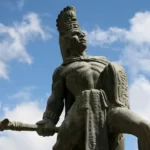The Book of Mormon has been the subject of scrutiny and debate for many reasons, one of which is its use of the word “white” in passages like the phrase “white and delightsome.” Critics often interpret this language as evidence of Joseph Smith’s 19th-century racial attitudes being reflected in the text. However, is it possible that this interpretation misses the cultural and linguistic context of the phrase? By taking a deeper look, we can consider whether the phrase “white and delightsome” might hold meanings unrelated to race, rooted instead in spiritual and cultural symbolism.
The text that frequently comes under fire is found in 2 Nephi 30:6, which originally read: “And then shall they rejoice; for they shall know that it is a blessing unto them from the hand of God; and their scales of darkness shall begin to fall from their eyes; and many generations shall not pass away among them, save they shall be a white and a delightsome people.” In 1981, the Church of Jesus Christ of Latter-day Saints made an adjustment to this verse, changing the phrase to “pure and a delightsome people.” For critics, this change is often viewed as an attempt to distance the church from its past and erase racially insensitive language. But is the issue truly that simple?
Understanding “White and Delightsome” in Context
To fully grasp the meaning of this phrase, it is necessary to consider the broader context of the Book of Mormon. If the book describes events involving real people in a Mesoamerican setting, as some Latter-day Saint scholars suggest, then the language and cultural nuances of the time must also be considered. One important lens through which to view this is the symbolic use of “light” and “darkness” in both spiritual and cultural terms.
Language and Symbolism in Mesoamerican Culture
In Mesoamerican cultures, including among the K’iche’ Maya, concepts of light and luminosity often carried profound spiritual and cultural significance. For example, the K’iche’ Mayan word saq translates to concepts such as brilliance, purity, or cleanliness. Far from being limited to physical descriptions, this word frequently referred to states of virtue, truth, and harmony. The archaeological site Saq Ulew, which means “the white land,” illustrates this well. The term “white” here does not reference race or skin color but instead represents fertility, productivity, and spiritual vitality.
The symbolic meaning of “white” is further highlighted in linguistic examples from K’iche’ Mayan culture:
- El pa saq: A phrase meaning a positive or successful experience, such as a prosperous marriage or business transaction.
- Saqalaj tzij: Refers to “truth,” emphasizing the clarity and brilliance of truthful words.
- Saqi K’oxol: Describes the manifestation of mountain spirits, tying luminosity to divine revelation or spiritual awakening.
The concept of light and darkness is often used metaphorically to describe states of righteousness, enlightenment, and spiritual awakening in many cultures. Mesoamerican languages, like those of the Maya, integrate these metaphors into their everyday language, suggesting that “white” in these contexts is not about skin color but rather about being in harmony with divine principles.
Darkness as a Counterpoint to Light
In contrast to “white” or “light” as symbolic of virtue and purity, the concept of “darkness” carried negative connotations in Mesoamerican traditions. However, even these negative uses often reflected moral or spiritual attributes rather than physical characteristics. For instance:
- Saq’or: A term for a lazy or unproductive person, highlighting an absence of the symbolic “light” of industriousness and virtue.
- Saq tza: A phrase meaning something that is unsalted, bland, or lacking vitality.
- Q’änal saqmol: Refers to the egg yolk, a contrast to the white of the egg, often symbolically linked to what is less pure or lacking spiritual refinement.
Through these examples, we see that terms associated with “white” and “light” in Mesoamerican cultures consistently align with symbolic meanings of virtue, purity, and productivity, rather than physical attributes. Applying this cultural lens to the Book of Mormon suggests that “white and delightsome” may similarly reflect a spiritual state rather than a racial one.
A Broader Scriptural Perspective
The use of light and whiteness as metaphors for spiritual purity and enlightenment is not unique to Mesoamerican languages or the Book of Mormon. Similar themes appear throughout the Bible, which Joseph Smith and early Latter-day Saints regarded as foundational scripture. For example, Isaiah 1:18 declares: “Though your sins be as scarlet, they shall be as white as snow.” This passage, like the one in the Book of Mormon, connects the concept of “white” to purity and the removal of sin, rather than to race or skin color.
In the New Testament, Jesus describes his disciples as “the light of the world” (Matthew 5:14), further emphasizing the metaphorical use of light and brightness to signify spiritual enlightenment and righteousness. The Book of Mormon, as another testament of Jesus Christ, adopts and reflects similar imagery. Therefore, it is reasonable to interpret “white and delightsome” in this metaphorical tradition, representing the transformative power of righteousness and divine blessings.
Interpreting the 1981 Change to “Pure and Delightsome”
The change from “white” to “pure” in the 1981 edition of the Book of Mormon has often been cited as evidence of the Church attempting to obscure its past. However, the change can also be understood as an effort to clarify the intended meaning of the text in light of modern interpretations of the word “white.” By the late 20th century, racial connotations of the word “white” had become much more prominent in public consciousness, making it more likely to be misinterpreted as referring to skin color. The shift to “pure and delightsome” aligns with the broader scriptural tradition of associating whiteness with spiritual purity, while avoiding contemporary racial implications that were not present in the original context.
The Importance of Context in Modern Interpretations
One of the challenges in interpreting ancient texts like the Book of Mormon is the tendency to project modern assumptions onto them. In 19th-century America, concepts of race were often tied to physical attributes like skin color. This cultural context has led many critics to assume that “white and delightsome” must reflect Joseph Smith’s racial attitudes. However, this interpretation does not account for the possibility that the phrase draws from older traditions of spiritual and symbolic language, as seen in Mesoamerican and biblical contexts.
When we consider the historical and linguistic settings of the Book of Mormon, an alternative interpretation emerges. The phrase “white and delightsome” may be less about physical characteristics and more about describing a people who are spiritually transformed, productive, and aligned with divine principles.
Conclusion
The phrase “white and delightsome” in the Book of Mormon has long been a point of contention, often viewed through the lens of modern racial sensitivities. However, by examining the linguistic and cultural context of the text, particularly in light of Mesoamerican traditions, we find a compelling alternative interpretation. In these traditions, “white” and “light” are consistently associated with spiritual purity, truth, and harmony with divine principles. The 1981 change to “pure and delightsome” serves to clarify this symbolic meaning, making it more accessible to modern readers.
Critics who focus solely on the racial implications of the word “white” risk missing the richness of the text’s symbolic language and the broader message of spiritual transformation it conveys. Understanding “white and delightsome” in its proper context allows us to appreciate the depth and complexity of the Book of Mormon, while also challenging us to move beyond simplistic and anachronistic interpretations. The phrase invites readers to consider what it truly means to be “delightsome” in the eyes of God—something that transcends physical characteristics and speaks instead to the state of the heart and soul.





